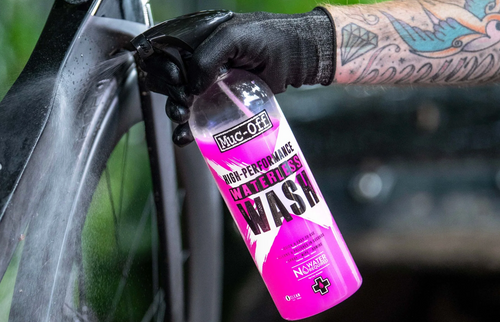When a puncture in your tubeless tire is simply too big to seal, the Muc-Off Puncture Plug Repair Kit is the ultimate backup tool that’s lightweight and easy to use.
Inside the kit, you'll find a tough stainless-steel tool that doubles up as both a reamer and a plug, with a durable handle on the top that makes it compact and lightweight. You'll also get two different sizes of puncture plugs, which will seal multiple holes and cover you for a variety of different sized punctures.
To keep everything nice and secure, the kit comes complete with a tough Cordura pouch. Since the tool is sharp, it has a rubber fitment on the top for safety, and if you keep it inside the pouch, and inside a saddle bag, you'll be well covered.
How do you use them?
We have this video which will show you all the steps:
Or if you'd rather read how to do it, check out our step-by-step guide below:
- Step 1: To start, you'll need to remove the source of the puncture. Just be careful when you're doing this in case there is anything sharp inside the tire. For a larger hole, you're only initially going to need to use the reamer section of the tool.
- Step 2: Insert the tool down into the tire up to the reamer section, and then move it backwards and forwards just to roughen up the edges. This allows the plug to create a better seal when you go ahead and put it into the tire.

- Step 3: Once you've roughed up the inside of the hole, take one of the larger puncture plugs, pinch the end down, thread it into the very end of the tool, and pull it through until it's about halfway in. Aim at the hole, press down until the puncture plug is around halfway in.

- Step 4: To remove the tool from the tire, twist it a few revolutions while holding the sides of the plug down, then pull it out slowly. If you have something to trim the excess, go ahead and do so. If not, you can do it later. When trimming, be careful not to take off too much or damage the tire.
- Step 5: With the hole in the tire now plugged, you'll need to reinflate it – we recommend using one of our CO2 canisters. Once you've done this, give the wheel a few rotations to get the sealant flowing, and then it’s good to go back on your bike.







 Muc-Off UK
Muc-Off UK
 Muc-Off EU
Muc-Off EU
 Muc-Off US
Muc-Off US
 Deutsch
Deutsch
 Francais
Francais
 Espanol
Espanol
 Italiano
Italiano
 Nederlands
Nederlands
 Polski
Polski






